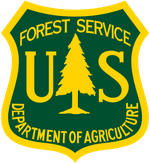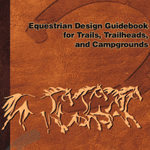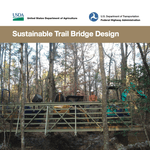Off-Highway Vehicle Trail and Road Grading Equipment
Trail Competencies
-
Trail Construction
- • Mechanized Trail Construction
-
Summary
The Missoula Technology and Development Center (MTDC) was asked to find a good way to maintain a 40-mile (64-k) motorcycle and all-terrain-vehicle (ATV) trail on the Francis Marion National Forest in coastal South Carolina. Heavy use leaves a washboard surface that progresses to mounds and gullies several feet across. These are called "whoop-de-doos," and trail users find them both unpleasant and unsafe.
Overview
The problem of whoop-de-doos is not unique to this trail in the sandy coastal plain of South Carolina. We began the project by asking off-highway vehicle (OHV) trail managers throughout the Forest Service how they were maintaining their OHV trails. Several National Forests had developed prototype lightweight graders that could be towed behind ATV's, effectively removing whoop-de-doos with routine maintenance. MTDC worked with two of these Forests to further improve and evaluate these prototypes, tested them in South Carolina, and looked to the open market for similar equipment.
This report focuses on three pieces of equipment tested in South Carolina: a modified trail rock rake suggested by Cam Lockwood on the Angeles National Forest, CA; a trail drag designed by Dick Dufourd and Kim Larsen for use on the Deschutes National Forest, OR; and an Ultra Light Terrain Grader manufactured by The Shop Industrial, Lively, Ontario, Canada.
We found all three pieces of equipment suitable for OHV trails in sandy or pumice soils. They can all be pulled with ATV's. OHV trails are wider, typically at least 4 feet (1.2 m), than hiking or equestrian trails, and have fewer curves. All of the equipment would have functioned better on trails had the equipment been narrower.
The trail rock rake and the Ultra Light Terrain Grader worked exceptionally well on narrow roads like those found in camp-grounds, and for grading parking lots. They are a realistic and affordable alternative to full-sized graders for such applications.
In less detail, this report includes other ways that OHV trail managers are maintaining their trails. These include the TrailPlane developed by Mil Lill and used by the Cycle Conservation Club of Michigan; various drags, harrows, cultipackers, and rollers; and other techniques field personnel told us about.
Trail Types Covered
General. All trail types are relevant.
| Publisher | USDA Forest Service |
|---|
This link will take you away from TrailSkills.org. Please report broken links to us.
807 people have viewed this resource



